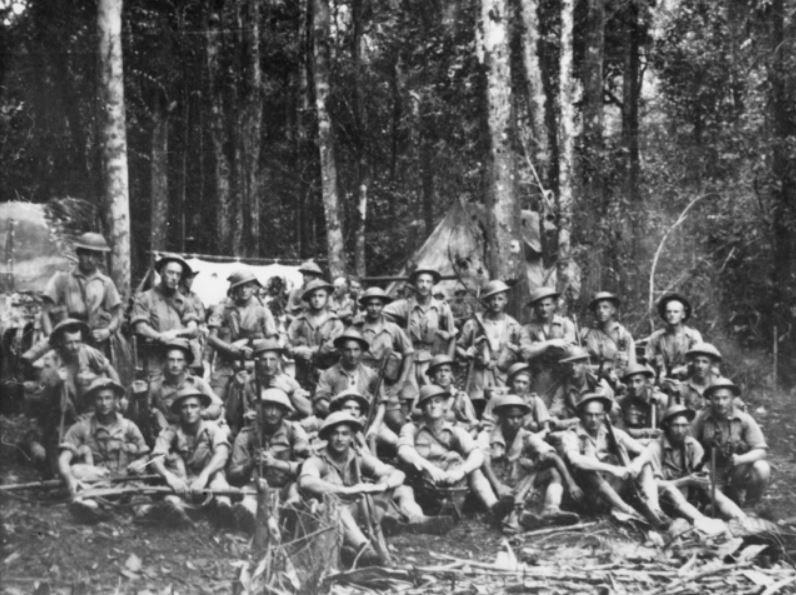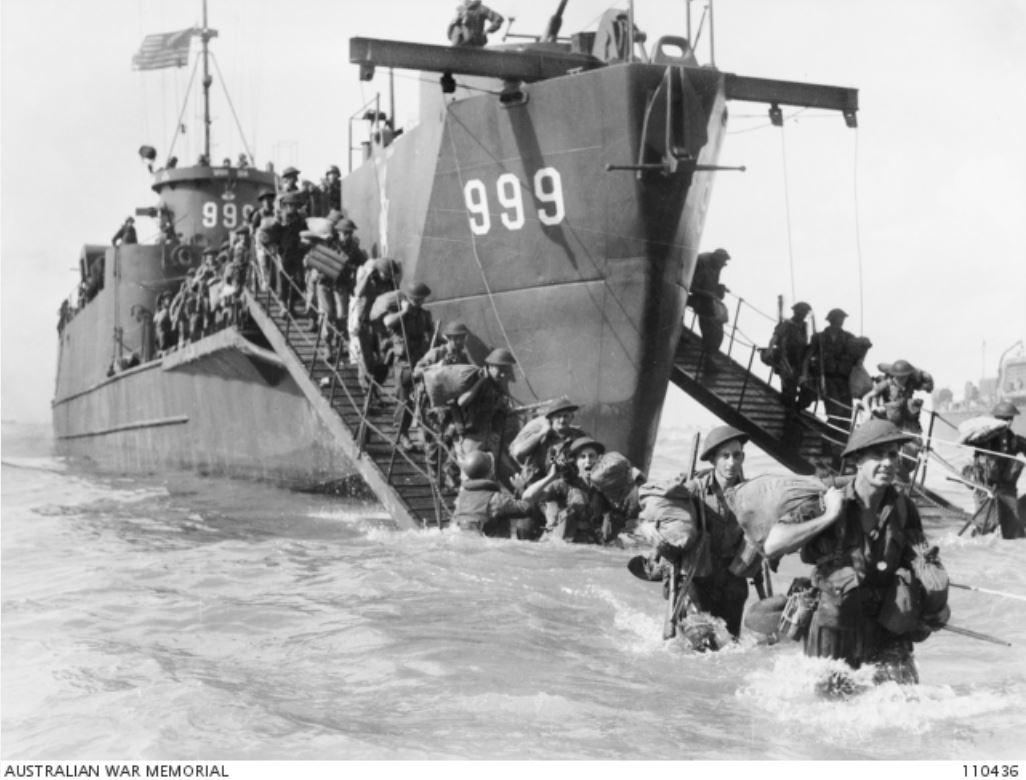2/14th Australian Infantry Battalion
From Our Contribution
 Men from 9 Platoon, 'A' Company, 2/14th Battalion at Kokoda on 16 August 1942 | |
 1 Jul 1945 landing from LCI 999 at Yellow Beach Balikpapan. | |
Contents
[hide]Brief History
The 2/14th Battalion was raised during May 1940 at Puckapunyal in Victoria. Following basic training it embarked for service in the Middle East from Sydney on 19 Oct 1940, and after stopping in India between 4 and 19 November, arrived in Egypt on 25 Nov 1940. After disembarkation, the battalion moved to Julis in Palestine to complete its training. The 2/14th was the first battalion of the 21st Brigade, part of the 7th Australian Division. In early April 1941, the 21st Brigade moved to Ikingi Maryut n Egypt to bolster the defences along the Libyan frontier against an expected German attack and the 2/14th occupied positions in the Mersa Matruh Fortress area. They returned to Palestine in late May to prepare for the invasion of Syria and Lebanon.
The 2/14th launched the 21st Brigade's operations in Lebanon, attacking the Vichy French frontier outposts in the early hours of 8 Jun 1941. Initially, the 2/14th took part in the drive along the coast and fought a major engagement along the Zahrani River on 12 June. It was later moved inland to Jezzine, to reinforce the 2/31st Battalion that had been counter-attacked, and mounted an unsuccessful attack to capture several precipitous features north-east of the town. The 2/14th's last major battle of the campaign was around Damour between 4 and 9 July. It remained as part of the garrison in Syria and Lebanon until early January 1942 when they returned to Hill 69 in Palestine.
Returning to Australia from Egypt on 30 Jan 1942, the 2/14th disembarked at Adelaide on 24 Mar 1942. After a short leave the battalion moved to Glen Innes in Northern New South Wales and then in May to Yandina from where they were to protect the beaches north of Caloundra. However, the Japanese advance along the Kokoda Track led to them arriving in Port Moresby in Papua on 13 August, and by 16 Aug 1942 they were advancing along the Kokoda Trail to confront the rapidly advancing Japanese. The battalion's first clash with them took place at Isurava on 26 August. After holding there for three days it was forced to withdraw. For his actions at Isurava, Private Bruce Kingsbury was posthumously awarded the Victoria Cross. The retreat back along the Trail was characterised by bitter, desperate fighting at Eora creek and Templeman's Crossing, but none more so than that which occurred at Mission Ridge between 6 and 8 Sep 1942. The 2/14th's ordeal on the Trail ended with its relief at Imita Ridge on 16 September. By this time the battalion was so weak that it had been amalgamated with the 2/16th to form a composite battalion. After a period of rest and retraining, the 2/14th, once again functioning as a separate battalion, joined the operations at Gona on 26 November. Comprising only three half-strength companies when it entered the fighting, the 2/14th left Gona, on 8 Jan 1943, only 21 strong.
Arriving back in Australia in late January 1943, the 2/14th was rebuilt and retrained at Ravenshoe before returning to Papua in early August. It spent a month conducting advanced training near Port Moresby before moving to New Guinea to play a minor role in the operation to capture Lae in mid-September. The battalion's main area of operations for 1943, however, was the Ramu Valley and the Finisterre Mountains where the Japanese had strong positions. It led the 21st Brigade's advance along the valley, from Kiapit to Dumpu, between 29 September and 5 October, and then spent the next five months engaged in patrol actions in the upper reaches of the valley and into the Finsterres. The battalion returned to Australia on 8 Mar 1944.
The 21st Infantry Brigade reassembled at Strathpine in Queensland, before moving with the rest of the 21st brigade to Kairi in North Queensland to await their next task. The 2/14th's last operation of the war was the Balikpapan landings. It left Australia on 2 Jun 1945, staged at Morotai in the Dutch East Indies and then landed at Balikpapan on 1 July 1945. Its major action of the campaign was around Manggaar Airfield between 4 and 10 July, before advancing towards Sambodja. By the end of July most objectives had been taken and they were then mopping up until the war ended. The 2/14th Australian Infantry Battalion sailed for Makassar in the southern Celebes on HMAS Burdekin and HMAS Gascoyne where they formed part of the occupation forces from 1 Oct 1945 to 17 Jan 1946 before sailing for home for the last time on 22 Jan 1946. It was disbanded in Brisbane on 22 Feb 1946. 232 men had died while a member of the battalion during the war.
Battalion Personnel
- Ralph Godfrey 19 Jan 1942 - 18 Apr 1943
Battle Honours
- Jezzine
- Damour
- Adlun
- Syrian Frontier
- Syria 1941
- Kokoda Trail
- Isurava
- Eora Creek-Templeton's Crossing I
- Efogi-Menari
- Ioribaiwa
- Buna-Gona
- Gona
- Amboga River
- Ramu Valley
- Shaggy Ridge
- Borneo 1945
- Balikpapan
Individual Honours
- 1 x Victoria Cross
- 1 x The Most Excellent Order of the British Empire
- 4 x Military Cross
- 3 x Distinguished Conduct Medal
- 19 x Military Medal
- 1 x British Empire Medal
- 44 x Mentioned in Despatches
Notes
Content has come from the AWM Website [1] accessed 21 Sep 2020, and The Unit Guide - Volume 2 - The Australian Army 1939-1945, pages 2.301 to 2.303 - Graham R McKenzie-Smith - Big Sky Publishing - 2018